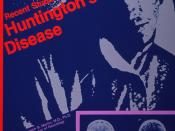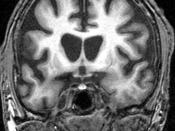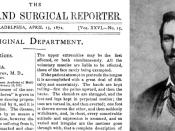Huntington's Background Huntington's disease is inherited as an autosomal dominant disease that gives rise to progressive, elective (localized) neural cell death associated with choleric movements (uncontrollable movements of the arms, legs, and face) and dementia. It is one of the more common inherited brain disorders. About 25,000 Americans have it and another 60,000 or so will carry the defective gene and will develop the disorder as they age. Physical deterioration occurs over a period of 10 to 20 years, usually beginning in a person's 30's or 40's. The gene is dominant and thus does not skip generations. Having the gene means a 92 percent chance of getting the disease. The disease is associated with increases in the length of a CAG triplet repeat present in a gene called 'huntington' located on chromosome 4. The classic signs of Huntington disease are progressive chorea, rigidity, and dementia, frequently associated with seizures. Studies & Research Studies were done to determine if somatic mtDNA (mitochondria DNA) mutations might contribute to the neurodegeneration observed in Huntington's disease.
Part of the research was to analyze cerebral deletion levels in the temporal and frontal lobes. Research hypothesis: HD patients have significantly higher mtDNA deletionlevels than agematched controls in the frontal and temporal lobes of the cortex. To test the hypothesis, the amount of mtDNA deletion in 22 HD patients brains was examined by serial dilution-polymerase chain reaction (PCR) and compared the results with mtDNA deletion levels in 25 aged matched controls. Brain tissues from three cortical regions were taken during an autopsy (from the 22 HD symptomatic HD patients): frontal lobe, temporal lobe and occipital lobe, and putamen. Molecular analyses were performed on genetic DNA isolated from 200 mg of frozen brain regions as described above. The HD diagnosis was confirmed in patients by...


